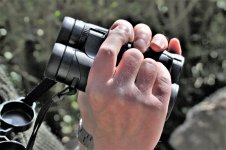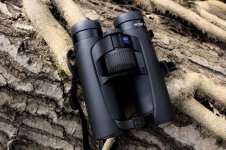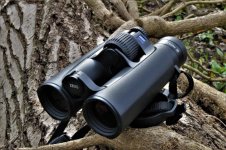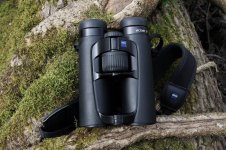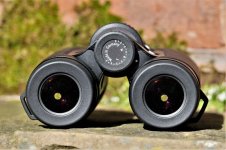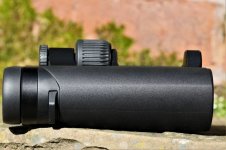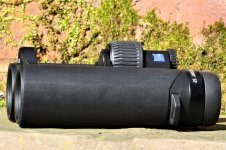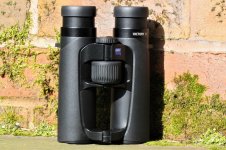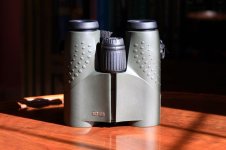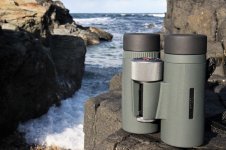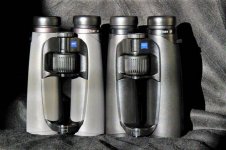These are strange times indeed, with Coronavirus controlling our everyday movements, or in my case, a lack of movement. As I explained in another recent review, our visits to the West coast and islands of Scotland are impossible at this time, so I started this review by exploring local countryside to test the capabilities of the SF. However, in less than a week, due to my high-risk status (I have a potentially fatal lung disease, currently stable), I was confined to our own property, which fortunately has a large area managed for wildlife and so offers a variety of observation opportunities, even if not quite on the scale of the Scottish Islands. Not so fortunately, the noisy outdoors activities of our neighbours who have been similarly confined to barracks, have had a knock-on effect on wildlife in our property, reducing the frequency of the observations and slowing the reviewing process down. It also meant that I have had to resort to a few non-animate subjects to test different aspects of the binoculars, as well as birds. As usual, my target is to ascertain whether the instrument under review can deliver useful and enjoyable birding and nature observation experiences, in keeping with its price level.
My test unit has been a Zeiss SF 8x32, the long-awaited medium-format follow-up to the 42mm models launched several years ago, and borrowed from Zeiss Germany for a short period. At the moment this model isn’t expected to reach dealers until August at the earliest. It is being priced on UK websites at around £2,065, but when supplies actually arrive this might change. This is certainly a strong price from Zeiss, but my experience in sales of technical products is certainly that if you have confidence in your product, it is better to price it in accordance with its capabilities, and not with reference to your competitor’s pricing. Competitor models are certainly Swarovski’s EL 8x32 priced in the UK at £1559 and Leica’s Ultravid HD Plus at £1398.
As usual, to put these models in perspective, we will take a look at their specifications and see how they compare on paper.
Zeiss SF 8x32
Field of view 155m at 1000m / 465ft at 1000yds, 8.81 deg.
Eye Relief 19mm
Close focus 1.95m, 6.4ft
Weight 600g, 21.2 ozs
Length 152mm, 5.9in
Swarovski EL 8x32
Field of view 141m, 423ft, 8deg
Eye Relief 20mm
Close focus 1.9m, 6.2ft
Weight 595g, 21ozs
Length 138mm, 5.3in
Leica Ultravid HD Plus 8x32
Field of view 135m, 404ft, 7.7deg
Eye relief 13mm
Close focus 2.1m, 7.2ft
Weight 535g, 18.9ozs
Length 116mm, 4.57in
Leica’s offering looks attractive for those prioritising a compact size and light weight, but looks outclassed on field of view in this company, although for sure it’s fov is no disgrace. It also looks marginal on eye relief but I have no problem using Troubadoris’s Ultravid HD 8x32 while wearing spectacles, so perhaps the eye relief is not the problem it might appear to be.
Swarovski’s EL is the market leader, and with good reason, although it is not perfect, having a reputation for suffering from glare (non-image-forming light). At 595g it is light and has a good field of view at 141m or 423ft, although the Zeiss seriously betters it in this regard.
Zeiss’s newcomer is 5 grams heavier than the EL, which is less than the weight of a Euro 0.20 coin and exactly the same as a US nickel. Its big gun, and it is a whopper, is its field of view, which at 155m and 509ft is huge. This means that the area you see at 1,000 metres is 18,872 square metres or 20.8% more area than with the EL, and 31.8% more than the Ultravid. If this wasn’t enough, Zeiss has at the same time managed to increase eye relief by 1.0mm to 19mm compared with SF42, not an easy task when increasing the field of view so significantly. If you were wondering why SF32 has a more complex eyepiece than its 42mm cousin, then the extra 10% area of view (= an extra 0.39 deg true angle of view) and the extra 1mm of eye relief explain why. Of course, field of view isn’t the only criterion by which to judge binos, but it is so useful whether scanning sky, sea, lake or shore or when trying to grab a view of fast-flying close subjects such as warblers or finches, butterflies or dragonflies.
Before I pick up the SF, I should explain that I asked Zeiss for a review unit of an SF 8x32 and this is what I received. To be clear, that is all I received. So no straps or ocular/objective guards and no case. Next time I ask for a review unit I will write the list out in full. Seriously, I suspect dealers are being given priority for the full sets that one normally receives, and I would just like to thank Zeiss for sparing a unit at this very busy and very difficult time. This means that the neck-strap and ocular guard in the photos are not necessarily like the ones that will come with SF32. One last word about accessories and that is to report two aspects of the case that is to be supplied with it. Firstly, it is not a version of the semi-hard, clam-shell, design supplied with SF42, which will please those who had trouble fitting their SF42 into it. I haven’t seen the case in the flesh yet, but take a look at the photo below, and you will get a good idea of it. The weave appears to be of a fine high quality, and it is good to know that the fabric is actually made from recycled PET bottles and so helps our environment.
At last it is time to pick the SF up and see how it feels in the hand. I said in my ‘First Impressions’ https://www.birdforum.net/showthread.php?t=387251 that “it is long enough to allow a good open-hinge grip with three fingers wrapped around the barrel just under the second bridge and your first finger falling naturally on the focus wheel, just as it does on the 42. By the way my IPD is only 58.5mm so my grip was achieved even with the hinge closed quite a lot”. Take a look at the first photo below to see what this looks like. Bigger hands will still find a place for the little finger either against the third bridge or on top of it.
Personally, I really like how ‘open-hinge’ doesn’t just mean a style of binocular with SFs. It offers an opportunity to grip the binocular securely, while comfortably reaching the focus wheel, so for me, this ‘open-hinge grip’ is of practical benefit. Of course other grips are possible but this one works well for me and I encourage others to try it. As with SF42 the centre of gravity of the bino has been shifted towards the eyepiece, the benefits of which have been explained previously. Undoubtedly the more complex eyepiece has contributed to this, bringing additional weight to the eyecup-end of the binos, but work has also been done to move weight in this direction at the objective end as well. Here, the external lens is a singlet instead of the 42mm’s doublet, and the focusing lens is now a doublet instead of the 42mm’s singlet. All of this means that SF32 simply feels lighter when lifted up in the hand than it otherwise would.
The focuser on this unit feels exquisitely smooth and precise, and is totally without free-play / backlash and the focus speed is very similar to that of SF42.
Moving on to the eyecups, I note that they are the revised design fitted to SF42 in more recent times, and far more in line with the price of the binocular than those originally fitted to SF42. My slim-lensed spectacles cause minor blackouts with many models, including this one when the eyecups are fully down, so I had to adjust the eyecups and noted they have 4 well-spaced and secure positions. Trying them out with the eyecups extended and without spectacles, the view was fine, and even jamming the eyecups into my sockets did not provoke blackouts.
Stepping outside to use the nearby black wooden poles and black overhead cables to check for chromatic aberration, I couldn’t find any at all, but what I did find was a Buzzard. What terrific luck!
Behind the house just up the hill from us, a Common Buzzard, Buteo buteo, came floating up, circling round and round in a convenient thermal. As it turned and banked-over somewhat, I got a clear view of the underside of its wings. Buzzards vary a lot with their plumage but this one had an ebony-black chequerboard pattern set against a dazzling silky-white background. There was no chromatic aberration around the rim of the image and the precision of the markings indicated clearly that the SFs have great apparent sharpness. To my surprise another Buzzard drifted-in to join the first and as they circled I could clearly see the tips of the primaries bowing upwards. As if this was not enough raptors flying over our neighbourhood, these two were joined by not only two more Buzzards, but also a Sparrowhawk, a female from its size. For a couple of minutes these 5 seemed to pass the time of day together and then for no obvious reason, the Sparrowhawk glided away and so did two of the Buzzards. This got the SF off to a flying start.
The following day I compared the SF to Troubadoris’s Ultravid HD 8x32 (not HD Plus) and quickly found the SF had a little better perceived sharpness, when viewing farm buildings 4km / 2.5 miles away in the cool early-morning before heat shimmer began. Checking out the bark and cracks on a nearby Birch tree perhaps explained this, because the SF had clearly better contrast, the silver bark being almost dazzling, and the cracks and other dark marks simply more clearly delineated, compared with the Ultravid. On colours, the Leica had the merest hint of more red than the Zeiss, otherwise they were too close to call. And to be clear, nobody who looked through the Leica would ever say ‘this is not sharp’, it certainly is sharp, but in a side by side comparison with the SF the latter’s contrast made the view just a little more punchy. In fact when comparing it with SF42, I have to say the 32 has a fraction more contrast than this too.
Talking of sharpness, the SF is razor sharp across the field of view and also at the very edge of the field. Just in-board of the extreme edge there is a narrow band where the sharpness softens just a fraction before recovering again at the edge. This band is very subtle and is not visible during normal viewing. SF42 has something similar and it was commented on by Gerald Dobler in the interview posted on Birdforum. The earliest model so far reported to have this (according to Kimmo Absetz) is Nikon’s SE 10x42. Holger Merlitz attributes this to the use of Smyth field-flattening lenses, especially the doublet versions. Both SF42 and 32 have singlet field-flatteners. In the field, birds are easily observed and identified when arriving at the field edge, as I found when at different times Goldfinch, Dunnock and Bullfinch gate-crashed the field of view. Granted they are all familiar to me and two of them are colourful, but if any unusual bird appeared at the edge, one would surely want to centre it in the field of view in order to identify it to species.
While we are discussing features of the field of view, apart from remarking on how generous it is, I should mention the pattern of distortions present as requested by Henry. The pattern resembles that of SF42 but differs in that the pincushion distortion applied to the bulk of the field of view is somewhat reduced in SF32, straight lines do not curve quite as much, and the position where curved lines recover their straightness is closer to the field edge than in SF42. Newcomers alarmed by the casual mention of distortions should be aware that all binoculars have distortions and that pin-cushion distortion is created deliberately to counter the effect known as ‘rolling globe’.
While pondering on all this, there was a movement high up in the Birch I was sitting near, and I tried to see what had arrived there but at first only got glimpses of two tiny birds, seemingly tumbling down through the dense twigs. Then they arrived at a more open part of the canopy, and hung underneath a couple of twigs like a pair of trapeze-artists practising their skills. Their tails and diminutive size and shape identified them as Long-tailed Tits, a favourite species of mine. One of them swung up on top of the twig and treated me to a head-on view. The UK variety of this little bird has a humbug-striped head with a white stripe over the centre of the crown, down to its beak, and two black stripes above each eye. Through the SFs, with its tiny black eyes and small beak, it was impossibly cute, with a colour on its ‘shoulder’ that I find difficult to give a name to. It is almost pink, but not quite. A really beautiful little bird, and exquisite through the SFs, with every tiny detail of the feather vanes on its face and neck plumage visible.
Later a nearby early bee was buzzing around our patch of Rosemary so I gave the SF’s close focus a try but had to step back a little as I was too close for the 1.95 metre close-focus distance. I am probably spoiled a bit by having binos with a close focusing distance of 1.5 metres (or even less), but 1.95 metres is surely close enough for most purposes.
On the last day of freedom before being confined to our property, I took a walk to the border with the next county and overlooked the wide bowl at the end of our valley, as it climbs up towards a ridge. And there circling around were three Buzzards, but I had no time to view these as a female Kestrel came whipping over a nearby hedge, flying low like a Merlin, and as I spun around and lifted the SFs the big field of view captured the speeding bird and gave me a brief but good view before it dipped out of sight. This was getting late in the afternoon and gave a good opportunity to verify yet again that the SF has great control of glare. During normal viewing I never saw any glare and needed to point them far closer to sun than I would normally dare before there was the merest hint of it in the lower part of the field and I don’t mean a crescent of light, just the tiniest diffuse suggestion of it, in a limited area that was nowhere near enough to obscure any part of the image. A quick check holding the binos up at half arms-length showed the reason why. Around the exit pupils there was nothing but blackness, no unwanted points of light. While I was checking for glare by varying the angle of the binos relative to the sun I also checked for the presence of ‘orange arcs’ at the rim of the field of view, as requested by Dennis, and found absolutely nothing, whether wearing spectacles or not. During this I also tried panning at different speeds to check for Rolling Ball/Globe and I didn’t see any, but please note I suspect I am not sensitive to this phenomenon as I have never seen it in other models either.
Being confined to our property, with noisy neighbours at home on each side, meant having to use whatever subjects were available, so to check colour reproduction I turned to a combination of birds, flowers and berries. Of particular note was the SF’s rendering of different yellows from the dense dark yellow of Marsh Marigold through the mid-tones of Cowslip to the delicate pale yellow of Primrose. I checked-out these latter several times under different lighting conditions since such a delicate shade could easily be ‘muddied’ by any intruding colour cast, but this did not happen. The blues on our resident Blue Tits were vivid and the reds on the faces of our Goldfinches, on two Rosehips surviving from last year, and on the chest of our Bullfinches, were really quite startling. Finally a check on the greens verified the different tones of Hawthorn, Mountain Ash and just-opening Pedunculate Oak, were all reproduced accurately. But before I leave colour behind I must just mention our resident male Blackbird who, while the female foraged nearby, turned out to be not as black as ebony but the deepest shade of Guinness brown. Maybe this is his first year of adulthood as all of our adult males in the past have been black. The reason to mention this here is just that it is another example of these binos reproducing a subtle tone accurately and he looked stunning with the orange ring around his eye and slightly curved orange beak.
Moving on to apparent sharpness, I have already mentioned the underwing plumage of the Buzzard, and the face and neck feathers of the Long-tailed tit, but I failed to report the detail of a Wren which stopped to have a bath in our pool, and gave me great views as it preened and dried off afterwards. The tips of the vanes on its feathers as it gave it’s plumage a vigorous going-over were a delight to see. But there was one thing better than this, although it may not sound impressive to all readers. One of the earliest hoverflies to be present in our garden in Spring is the species Eristalis tenax, which over-winters in a kind of hibernation and emerges to hover at various heights on the lookout for mating opportunities. While sitting outside I spotted one of these hovering about 8 metres away and as it turned to face away from me I got a clear and sharp view through the SFs of its legs sticking out behind it. It zoomed to a different position but the large field of view allowed me to stay on it and as it hovered, there were its tiny legs again. OK, so it’s not like seeing a Sea Eagle’s talons but in lock-down one has get one’s excitement wherever available, and these tiny limbs, rendered so sharply, excited me! But best of all were the markings on the underside of the Buzzard’s wings, the Long-tailed Tits face and neck where I could see how the vanes of the feathers were orientated, and the detail of the Wren’s plumage as it preened.
How to sum up? Is this Zeiss’s best binocular ever? It is certainly a candidate. It would be a bold claim, and anyone who says they prefer a 42mm for dawn and dusk observation has plenty of justification, as do the fans of 7x magnification. Is there anything I would change? Yes. I could wish that the close focus was 1.5 metres instead of 1.95m, but I can live with this. I would also like to see 5 positions of the eyecups, with the lower and upper pairs of positions closer together, so that both non-spectacle and spectacle wearers had a little more fine-adjustability, leaving a fifth position in the centre for use by anyone. But this is being really nit-picking. SF32 is everything that SF42 is, but in a handier package with a field of view bonus. It has proved to be an enjoyable and satisfying instrument, fully justifying (IMHO) its premium pricing, and if I get the opportunity to take one to Scotland I will review it again. Anyone contemplating buying binoculars at or near this price point would be doing themselves a favour by having SF8x32 on their short-list.
Lee
My test unit has been a Zeiss SF 8x32, the long-awaited medium-format follow-up to the 42mm models launched several years ago, and borrowed from Zeiss Germany for a short period. At the moment this model isn’t expected to reach dealers until August at the earliest. It is being priced on UK websites at around £2,065, but when supplies actually arrive this might change. This is certainly a strong price from Zeiss, but my experience in sales of technical products is certainly that if you have confidence in your product, it is better to price it in accordance with its capabilities, and not with reference to your competitor’s pricing. Competitor models are certainly Swarovski’s EL 8x32 priced in the UK at £1559 and Leica’s Ultravid HD Plus at £1398.
As usual, to put these models in perspective, we will take a look at their specifications and see how they compare on paper.
Zeiss SF 8x32
Field of view 155m at 1000m / 465ft at 1000yds, 8.81 deg.
Eye Relief 19mm
Close focus 1.95m, 6.4ft
Weight 600g, 21.2 ozs
Length 152mm, 5.9in
Swarovski EL 8x32
Field of view 141m, 423ft, 8deg
Eye Relief 20mm
Close focus 1.9m, 6.2ft
Weight 595g, 21ozs
Length 138mm, 5.3in
Leica Ultravid HD Plus 8x32
Field of view 135m, 404ft, 7.7deg
Eye relief 13mm
Close focus 2.1m, 7.2ft
Weight 535g, 18.9ozs
Length 116mm, 4.57in
Leica’s offering looks attractive for those prioritising a compact size and light weight, but looks outclassed on field of view in this company, although for sure it’s fov is no disgrace. It also looks marginal on eye relief but I have no problem using Troubadoris’s Ultravid HD 8x32 while wearing spectacles, so perhaps the eye relief is not the problem it might appear to be.
Swarovski’s EL is the market leader, and with good reason, although it is not perfect, having a reputation for suffering from glare (non-image-forming light). At 595g it is light and has a good field of view at 141m or 423ft, although the Zeiss seriously betters it in this regard.
Zeiss’s newcomer is 5 grams heavier than the EL, which is less than the weight of a Euro 0.20 coin and exactly the same as a US nickel. Its big gun, and it is a whopper, is its field of view, which at 155m and 509ft is huge. This means that the area you see at 1,000 metres is 18,872 square metres or 20.8% more area than with the EL, and 31.8% more than the Ultravid. If this wasn’t enough, Zeiss has at the same time managed to increase eye relief by 1.0mm to 19mm compared with SF42, not an easy task when increasing the field of view so significantly. If you were wondering why SF32 has a more complex eyepiece than its 42mm cousin, then the extra 10% area of view (= an extra 0.39 deg true angle of view) and the extra 1mm of eye relief explain why. Of course, field of view isn’t the only criterion by which to judge binos, but it is so useful whether scanning sky, sea, lake or shore or when trying to grab a view of fast-flying close subjects such as warblers or finches, butterflies or dragonflies.
Before I pick up the SF, I should explain that I asked Zeiss for a review unit of an SF 8x32 and this is what I received. To be clear, that is all I received. So no straps or ocular/objective guards and no case. Next time I ask for a review unit I will write the list out in full. Seriously, I suspect dealers are being given priority for the full sets that one normally receives, and I would just like to thank Zeiss for sparing a unit at this very busy and very difficult time. This means that the neck-strap and ocular guard in the photos are not necessarily like the ones that will come with SF32. One last word about accessories and that is to report two aspects of the case that is to be supplied with it. Firstly, it is not a version of the semi-hard, clam-shell, design supplied with SF42, which will please those who had trouble fitting their SF42 into it. I haven’t seen the case in the flesh yet, but take a look at the photo below, and you will get a good idea of it. The weave appears to be of a fine high quality, and it is good to know that the fabric is actually made from recycled PET bottles and so helps our environment.
At last it is time to pick the SF up and see how it feels in the hand. I said in my ‘First Impressions’ https://www.birdforum.net/showthread.php?t=387251 that “it is long enough to allow a good open-hinge grip with three fingers wrapped around the barrel just under the second bridge and your first finger falling naturally on the focus wheel, just as it does on the 42. By the way my IPD is only 58.5mm so my grip was achieved even with the hinge closed quite a lot”. Take a look at the first photo below to see what this looks like. Bigger hands will still find a place for the little finger either against the third bridge or on top of it.
Personally, I really like how ‘open-hinge’ doesn’t just mean a style of binocular with SFs. It offers an opportunity to grip the binocular securely, while comfortably reaching the focus wheel, so for me, this ‘open-hinge grip’ is of practical benefit. Of course other grips are possible but this one works well for me and I encourage others to try it. As with SF42 the centre of gravity of the bino has been shifted towards the eyepiece, the benefits of which have been explained previously. Undoubtedly the more complex eyepiece has contributed to this, bringing additional weight to the eyecup-end of the binos, but work has also been done to move weight in this direction at the objective end as well. Here, the external lens is a singlet instead of the 42mm’s doublet, and the focusing lens is now a doublet instead of the 42mm’s singlet. All of this means that SF32 simply feels lighter when lifted up in the hand than it otherwise would.
The focuser on this unit feels exquisitely smooth and precise, and is totally without free-play / backlash and the focus speed is very similar to that of SF42.
Moving on to the eyecups, I note that they are the revised design fitted to SF42 in more recent times, and far more in line with the price of the binocular than those originally fitted to SF42. My slim-lensed spectacles cause minor blackouts with many models, including this one when the eyecups are fully down, so I had to adjust the eyecups and noted they have 4 well-spaced and secure positions. Trying them out with the eyecups extended and without spectacles, the view was fine, and even jamming the eyecups into my sockets did not provoke blackouts.
Stepping outside to use the nearby black wooden poles and black overhead cables to check for chromatic aberration, I couldn’t find any at all, but what I did find was a Buzzard. What terrific luck!
Behind the house just up the hill from us, a Common Buzzard, Buteo buteo, came floating up, circling round and round in a convenient thermal. As it turned and banked-over somewhat, I got a clear view of the underside of its wings. Buzzards vary a lot with their plumage but this one had an ebony-black chequerboard pattern set against a dazzling silky-white background. There was no chromatic aberration around the rim of the image and the precision of the markings indicated clearly that the SFs have great apparent sharpness. To my surprise another Buzzard drifted-in to join the first and as they circled I could clearly see the tips of the primaries bowing upwards. As if this was not enough raptors flying over our neighbourhood, these two were joined by not only two more Buzzards, but also a Sparrowhawk, a female from its size. For a couple of minutes these 5 seemed to pass the time of day together and then for no obvious reason, the Sparrowhawk glided away and so did two of the Buzzards. This got the SF off to a flying start.
The following day I compared the SF to Troubadoris’s Ultravid HD 8x32 (not HD Plus) and quickly found the SF had a little better perceived sharpness, when viewing farm buildings 4km / 2.5 miles away in the cool early-morning before heat shimmer began. Checking out the bark and cracks on a nearby Birch tree perhaps explained this, because the SF had clearly better contrast, the silver bark being almost dazzling, and the cracks and other dark marks simply more clearly delineated, compared with the Ultravid. On colours, the Leica had the merest hint of more red than the Zeiss, otherwise they were too close to call. And to be clear, nobody who looked through the Leica would ever say ‘this is not sharp’, it certainly is sharp, but in a side by side comparison with the SF the latter’s contrast made the view just a little more punchy. In fact when comparing it with SF42, I have to say the 32 has a fraction more contrast than this too.
Talking of sharpness, the SF is razor sharp across the field of view and also at the very edge of the field. Just in-board of the extreme edge there is a narrow band where the sharpness softens just a fraction before recovering again at the edge. This band is very subtle and is not visible during normal viewing. SF42 has something similar and it was commented on by Gerald Dobler in the interview posted on Birdforum. The earliest model so far reported to have this (according to Kimmo Absetz) is Nikon’s SE 10x42. Holger Merlitz attributes this to the use of Smyth field-flattening lenses, especially the doublet versions. Both SF42 and 32 have singlet field-flatteners. In the field, birds are easily observed and identified when arriving at the field edge, as I found when at different times Goldfinch, Dunnock and Bullfinch gate-crashed the field of view. Granted they are all familiar to me and two of them are colourful, but if any unusual bird appeared at the edge, one would surely want to centre it in the field of view in order to identify it to species.
While we are discussing features of the field of view, apart from remarking on how generous it is, I should mention the pattern of distortions present as requested by Henry. The pattern resembles that of SF42 but differs in that the pincushion distortion applied to the bulk of the field of view is somewhat reduced in SF32, straight lines do not curve quite as much, and the position where curved lines recover their straightness is closer to the field edge than in SF42. Newcomers alarmed by the casual mention of distortions should be aware that all binoculars have distortions and that pin-cushion distortion is created deliberately to counter the effect known as ‘rolling globe’.
While pondering on all this, there was a movement high up in the Birch I was sitting near, and I tried to see what had arrived there but at first only got glimpses of two tiny birds, seemingly tumbling down through the dense twigs. Then they arrived at a more open part of the canopy, and hung underneath a couple of twigs like a pair of trapeze-artists practising their skills. Their tails and diminutive size and shape identified them as Long-tailed Tits, a favourite species of mine. One of them swung up on top of the twig and treated me to a head-on view. The UK variety of this little bird has a humbug-striped head with a white stripe over the centre of the crown, down to its beak, and two black stripes above each eye. Through the SFs, with its tiny black eyes and small beak, it was impossibly cute, with a colour on its ‘shoulder’ that I find difficult to give a name to. It is almost pink, but not quite. A really beautiful little bird, and exquisite through the SFs, with every tiny detail of the feather vanes on its face and neck plumage visible.
Later a nearby early bee was buzzing around our patch of Rosemary so I gave the SF’s close focus a try but had to step back a little as I was too close for the 1.95 metre close-focus distance. I am probably spoiled a bit by having binos with a close focusing distance of 1.5 metres (or even less), but 1.95 metres is surely close enough for most purposes.
On the last day of freedom before being confined to our property, I took a walk to the border with the next county and overlooked the wide bowl at the end of our valley, as it climbs up towards a ridge. And there circling around were three Buzzards, but I had no time to view these as a female Kestrel came whipping over a nearby hedge, flying low like a Merlin, and as I spun around and lifted the SFs the big field of view captured the speeding bird and gave me a brief but good view before it dipped out of sight. This was getting late in the afternoon and gave a good opportunity to verify yet again that the SF has great control of glare. During normal viewing I never saw any glare and needed to point them far closer to sun than I would normally dare before there was the merest hint of it in the lower part of the field and I don’t mean a crescent of light, just the tiniest diffuse suggestion of it, in a limited area that was nowhere near enough to obscure any part of the image. A quick check holding the binos up at half arms-length showed the reason why. Around the exit pupils there was nothing but blackness, no unwanted points of light. While I was checking for glare by varying the angle of the binos relative to the sun I also checked for the presence of ‘orange arcs’ at the rim of the field of view, as requested by Dennis, and found absolutely nothing, whether wearing spectacles or not. During this I also tried panning at different speeds to check for Rolling Ball/Globe and I didn’t see any, but please note I suspect I am not sensitive to this phenomenon as I have never seen it in other models either.
Being confined to our property, with noisy neighbours at home on each side, meant having to use whatever subjects were available, so to check colour reproduction I turned to a combination of birds, flowers and berries. Of particular note was the SF’s rendering of different yellows from the dense dark yellow of Marsh Marigold through the mid-tones of Cowslip to the delicate pale yellow of Primrose. I checked-out these latter several times under different lighting conditions since such a delicate shade could easily be ‘muddied’ by any intruding colour cast, but this did not happen. The blues on our resident Blue Tits were vivid and the reds on the faces of our Goldfinches, on two Rosehips surviving from last year, and on the chest of our Bullfinches, were really quite startling. Finally a check on the greens verified the different tones of Hawthorn, Mountain Ash and just-opening Pedunculate Oak, were all reproduced accurately. But before I leave colour behind I must just mention our resident male Blackbird who, while the female foraged nearby, turned out to be not as black as ebony but the deepest shade of Guinness brown. Maybe this is his first year of adulthood as all of our adult males in the past have been black. The reason to mention this here is just that it is another example of these binos reproducing a subtle tone accurately and he looked stunning with the orange ring around his eye and slightly curved orange beak.
Moving on to apparent sharpness, I have already mentioned the underwing plumage of the Buzzard, and the face and neck feathers of the Long-tailed tit, but I failed to report the detail of a Wren which stopped to have a bath in our pool, and gave me great views as it preened and dried off afterwards. The tips of the vanes on its feathers as it gave it’s plumage a vigorous going-over were a delight to see. But there was one thing better than this, although it may not sound impressive to all readers. One of the earliest hoverflies to be present in our garden in Spring is the species Eristalis tenax, which over-winters in a kind of hibernation and emerges to hover at various heights on the lookout for mating opportunities. While sitting outside I spotted one of these hovering about 8 metres away and as it turned to face away from me I got a clear and sharp view through the SFs of its legs sticking out behind it. It zoomed to a different position but the large field of view allowed me to stay on it and as it hovered, there were its tiny legs again. OK, so it’s not like seeing a Sea Eagle’s talons but in lock-down one has get one’s excitement wherever available, and these tiny limbs, rendered so sharply, excited me! But best of all were the markings on the underside of the Buzzard’s wings, the Long-tailed Tits face and neck where I could see how the vanes of the feathers were orientated, and the detail of the Wren’s plumage as it preened.
How to sum up? Is this Zeiss’s best binocular ever? It is certainly a candidate. It would be a bold claim, and anyone who says they prefer a 42mm for dawn and dusk observation has plenty of justification, as do the fans of 7x magnification. Is there anything I would change? Yes. I could wish that the close focus was 1.5 metres instead of 1.95m, but I can live with this. I would also like to see 5 positions of the eyecups, with the lower and upper pairs of positions closer together, so that both non-spectacle and spectacle wearers had a little more fine-adjustability, leaving a fifth position in the centre for use by anyone. But this is being really nit-picking. SF32 is everything that SF42 is, but in a handier package with a field of view bonus. It has proved to be an enjoyable and satisfying instrument, fully justifying (IMHO) its premium pricing, and if I get the opportunity to take one to Scotland I will review it again. Anyone contemplating buying binoculars at or near this price point would be doing themselves a favour by having SF8x32 on their short-list.
Lee
Attachments
Last edited:




